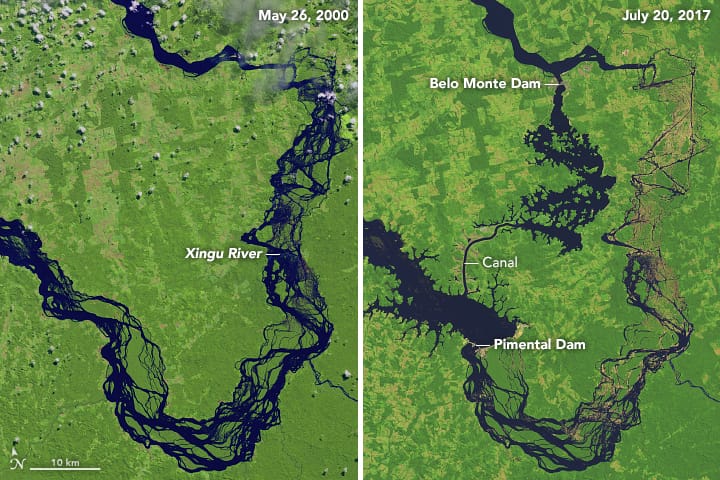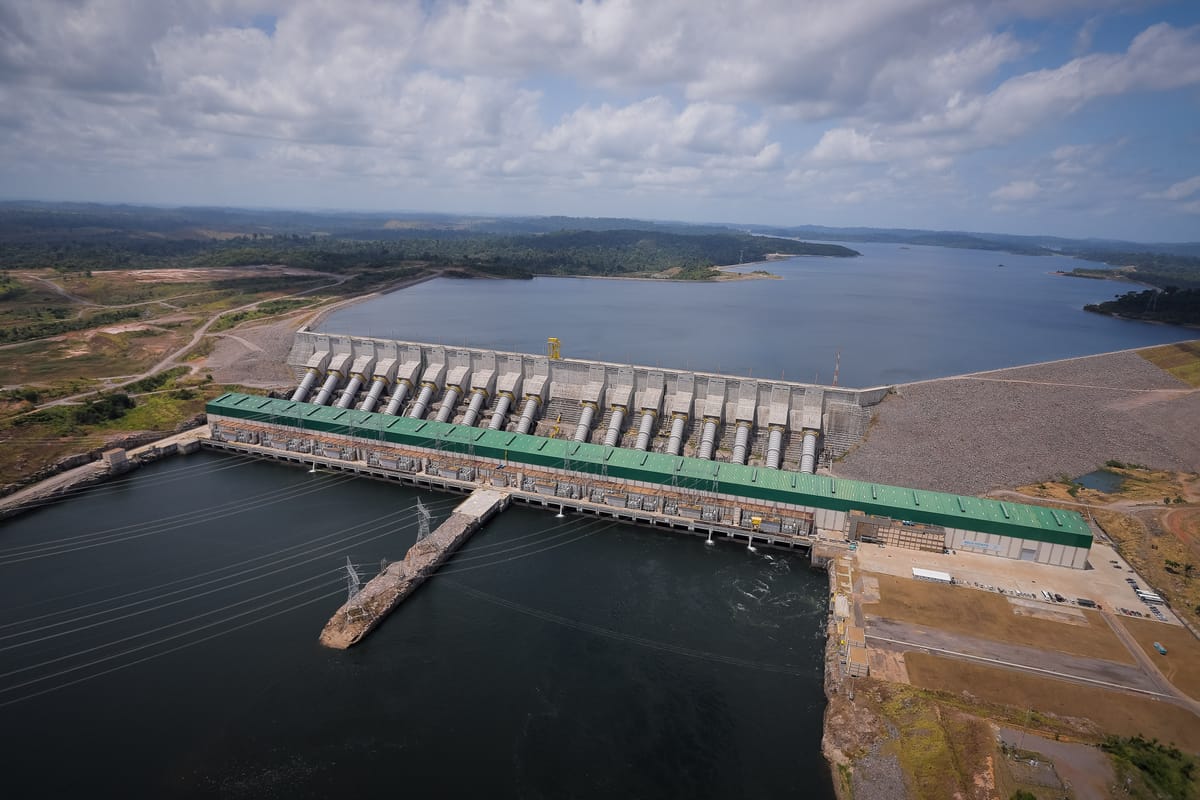Last December, at the largest international climate conference of the year, COP28, participants agreed to transition from fossil fuels to renewable energy sources in the next few years to help stem global warming. If tropical, resource-rich nations want to meet the Paris Climate Agreement goals of confining temperature rises to 1.5 degrees Celsius by limiting their carbon emissions, investing in hydroelectricity seems like a no-brainer. On the surface, it sounds great: hydroelectricity relies on flowing water from dammed up rivers to push a turbine, thereby producing no direct emissions while harvesting power by the megawatts. But hydroelectricity may not be as green as you think, and the environmental impacts are often ignored — or exacerbated by governments all too eager to initiate megaprojects and erect megastructures as monuments to their so-called climate commitments.
Take a nation that on the outset seems ideally suited to reap hydropower: Brazil. The Amazon basin is the largest drainage basin in the world. It nourishes a mighty river that dumps 209,000 cubic meters of water into the Atlantic Ocean every second, which amounts to about 20% of the discharge of all the world’s rivers. The existence of the river is mainly thanks to the Amazon rainforest. The rainforest’s flora release moisture in a process called transpiration, generating significant rainfall in the inner continent of Latin America which would otherwise be a desert. Forests also act like a sponge, soaking up rainfall in the ground and recharging groundwater supplies for lakes and rivers.
It is no wonder then, that Amazonian countries such as Brazil are taking advantage of its rivers for hydroelectricity generation. Half to 80% of Brazil’s energy is sourced from hydropower. Brazil also ranks second in the world for total hydropower capacity. During the COP28, Brazil signed a pledge to ramp up its hydropower-led renewable energy output as an alternative to coal.
While the increased reliance on hydroelectricity is generally a welcome trend, hydroelectricity has significant environmental sunk costs that are often neglected by energy policies. Constructing a dam requires flooding large swathes of land. All that submerged vegetation rots and produces methane, a major greenhouse gas 28 times more potent than carbon dioxide. For instance, researchers estimated that the methane emitted by Ohio’s largest hydropower reservoir in 2012 was equivalent to the belching of nearly 6000 flatulent cows, the most prolific agricultural source of greenhouse gases worldwide. Brazil and many other countries’ bandwagon pursuit of “clean” energy typically do not factor in methane production in the emission calculations.
For Brazil, which houses 60% of the Amazon rainforest, the flooding from dam construction is particularly troubling as it stands antithetical to the rainforest protection movement. In 2011 and 2013, the construction of just two dams—the Santo Antonio and the Jirau — across the Madeira tributary in western Brazil flooded a rainforest area half the size of New York City. The CO2 that could have been absorbed by the drowned rainforests in a year was more than the emissions of 770,000 cars on the road. The Brazilian Amazon is currently home to 32 operating dams, and at least 31 more dams are in the works over the next few years.
Brazil’s dam-building spree has another ugly side — the displacement of indigenous communities and the erosion of their rights. The costs of dam-building fall disproportionately onto the indigenous communities as their ways of life are intertwined with the rainforest. Flooding rainforests to make way for dams expels indigenous communities from their homes, oftentimes into shoddy government housing in “civilized” society. With flooding comes significantly altered riverways and ecosystems turned upside down, decimating the local biodiversity and major food sources.

One of the world’s most notorious hydroelectric projects is the Belo Monte Dam that slices the Xingu River in Brazil’s northern state of Pará. Completed in November 2019, the hydroelectric complex on the Xingu is roughly the fifth largest in the world by installed capacity. The project was controversial long before the first concrete slab was laid down. Norte Energia, the company contracted to build the dam, conducted sham assessments that underestimated the project’s environmental impacts. Contrary to Brazil’s constitution, the indigenous community was not consulted for the project, yet they were the party most affected.
A whopping 80% of the Xingu River was rerouted, annihilating traditional indigenous fishing spots. The dam threatened the habitats of 600 species of fish and turtles, many of which were unique to the region. Over 20,000 people were displaced from the 260 square miles of flooded forests and lowlands.
The Belo Monte dam was not “green” by any measure — construction alone produced more greenhouse emissions than what would be saved by 41 years of the dam’s optimal energy production.
Belo Monte is the only first falling domino in the Brazilian government’s push to build a chain of dams further upstream. By the time all the dams are built, half of the Amazon basin will be affected. Two thirds of Brazilian Amazonia will be flushed of its indigenous inhabitants.

The Belo Monte project is not an isolated example of hydropower’s environmental and ethnocidal footprint. All around the world, hydroelectric plants are racking up controversy. In Nepal, the government is planning the billion-dollar Sapta Koshi High Dam in a poverty-stricken, earthquake-prone site in the southwest corner of the country. Locals have opposed its construction due to the unfair distribution of economic benefits and fears of losing their homes in the floodwaters. When Turkey’s Ilisu Dam began its operations in 2019, southeastern Turkey’s last pristine riverine and canyon ecosystems was flooded, along with ancient human settlement sites in the region dating as far back as 12,000 years. The world’s largest power station, China’s Three Gorges Dam has reduced the nation’s coal consumption, but the dam frequently triggers landslides and earthquakes, has worsened flood control, threatens the Yang Tze River’s unique biodiversity, and promotes the spread of infectious diseases.
Hydropower is destructive not only for its vast environmental toll, but also for the unforeseen costs that may take years to manifest. For example, in Senegal, the operation of the Diama dam led to millions of water-borne schistosomiasis infections three years later, defying all pre-construction predictions. The resulting chain of events can be quite complicated — in Senegal, the stock depletion of migratory river prawns resulted in the ballooning of freshwater snails, the prawn’s prey and the culpable host of Schistosoma parasite — and may not be apparent from the get-go, even if good-faith assessments are conducted beforehand, however thorough.
With a soaring global population and a greater demand for energy, countries need to increase their energy productivity without adding to the climate problem. We need to be serious about slashing our greenhouse gas emissions, but pursuing hydroelectricity is not a good way to do it. The better news is, there are greener alternatives: solar, wind, geothermal, and tidal energies. Brazil, for example, is blessed with solar and wind sources that the government has neglected in its energy policies thus far. The entire world can and should invest in increasing the efficiencies of their current energy infrastructure, instead of merely increasing the number of energy plants. A 2007 study showed that Brazil stands to reduce its energy consumption by 40% — equivalent to the output of 14 Belo Monte plants — by investing in energy efficiency.
Hydropower has become a slogan for countries to showcase their pseudo-commitment to the Paris Climate Agreement goals. But the construction of hydropower plants is often rooted in economic and political motives rather than a genuine concern for the climate. Hydropower should not be the go-to solution to hold back the floodtide of climate change, as history has repeatedly demonstrated. Nevertheless, if hydropower appears to be the best option among all the other possibilities, a transparent and honest assessment should be carried out beforehand, with all parties fairly compensated for the regrettable losses of a deluged land.




